In the future, a network of shared paths and cycleways could cover much of Te Awamutu and Cambridge – but why?
‘The current system of just relying on cars is not going to cut it’ – Bryan Hudson

Transport manager Bryan Hudson. Photo/ Benjamin Wilson
“The reality right now is that we can’t just widen or create more roads to accommodate more cars, nor can we expect to park outside our favourite shop at any time, hard to accept but a reality for fast growing communities,” said deputy mayor Liz Stolwyk, who is the chair of the council’s urban mobility Governance Group.
This push towards active transport is called mode shift, and it is what the council’s Urban Mobility Business Showcase encourages.
“It is recognising that as New Zealand grows, the current system of just relying on cars is not going to cut it. The business-as-usual approach is going to grind to a halt, and we won’t meet the government’s emissions goals,” said transportation manager Bryan Hudson.
Under the Paris Accords, New Zealand agreed to reduce its greenhouse emissions to 30 per cent of what they were in 2005 by 2030. Hudson says the move towards active and public transport is critical in reaching that target.
It would also reduce congestion and road maintenance costs, while improving air quality and the health of active transport users.
The council estimates that with the proper infrastructure, both Te Awamutu and Cambridge could shift 20 per cent of their transport away from private cars over time. That would equate to a seven to 10 per cent reduction in transport emissions.
“Part of our job is to showcase what can be done and get people to think differently because it is quite a mindset change,” said Hudson.
“During Covid, people said our streets were so much nicer without all that traffic on them. People got a taste of what it could be like.”
An estimated 30 per cent of car trips in town are less than six kilometres in distance.
Dawn Inglis, the council’s Service Delivery group manager, said people have become used to a high level of convenience in their lives, and need to think more carefully about the choices they make.
When discussing mode shift projects, Hudson says the focus is often on the negative impacts of moving away from cars, with angst typically given to the loss of car parks and the cost of building new infrastructure.
“It is alright for old guys like me, it’s not so stressful because I have been through it all before. I guess I am protective of the junior staff who encounter that for the first time, or when they get it badly and it really stresses them out. It is about understanding that we are dealing with human beings,” said Hudson.
Two weeks ago, Te Awamutu Community Board members criticised the council’s urban mobility plans, saying cyclists couldn’t justify the removal of some Mahoe Street carparks in favour of a cycleway.









